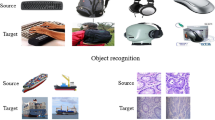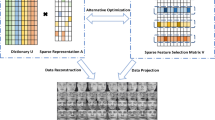Abstract
Dictionary learning has drawn increasing attention for its impressive performance in obtaining the high-fidelity representations of data and extracting semantics. However, when there exists distribution divergence between source and target data, the representations of target data based on the learned dictionary from source data fail to reveal the intrinsic nature of target tasks, which consequently degrades the target performance severely. To tackle this problem, we propose a Shared Dictionary Learning (SDL) method in this paper. SDL learns a shared dictionary by implementing both geometric and statistical adaptations. SDL utilizes the Nyström method to exploit the geometric relationships between domains. Specifically, SDL uses the Nyström method to construct a variable source graph based on the target graph eigensystem and employs the Nyström approximation error to measure the distance between the variable source graph and the ground truth source graph to formalize the geometric divergence. Thus, a domain-invariant graph can be constructed by minimizing the approximation error and can be used to bridge two domains geometrically. Simultaneously, SDL captures the latent statistical commonality underlying two domains via minimizing the Maximum Mean Discrepancy (MMD) distance between domains. Finally, SDL achieves a shared dictionary and a set of corresponding new representations to handle cross-distribution data classification. Extensive experimental results on several popular datasets demonstrate the superiority of SDL.



Similar content being viewed by others
Explore related subjects
Discover the latest articles, news and stories from top researchers in related subjects.References
Andersen M, Dahl J, Liu Z, Vandenberghe L, Sra S, Nowozin S, Wright S (2011) Interior-point methods for large-scale cone programming. Optimization for machine learning. MIT Press Cambridge, MA
Bnouni N, Rekik I, Rhim MS, Amara NEB (2019) Cross-view self-similarity using shared dictionary learning for cervical cancer staging. IEEE Access 7:30079–30088
Cao X, Wipf DP, Wen F, Duan G, Sun J (2013) A practical transfer learning algorithm for face verification. In: Proceedings of the IEEE International Conference on Computer Vision pp 3208–3215
Chen W, Hu H (2020) Unsupervised domain adaptation via discriminative classes-center feature learning in adversarial network. Neural Process Lett 52(1):467–483
Chen Y, Song S, Li S, Yang L, Wu C (2019) Domain space transfer extreme learning machine for domain adaptation. IEEE Trans on Cybern 49(5):1909–1922
Cheng L, Pan SJ (2014) Semi-supervised domain adaptation on manifolds. IEEE Trans on Neural Networks and Learning Syst 25(12):2240–2249
Deng C, Tang X, Yan J, Liu W, Gao X (2016) Discriminative dictionary learning with common label alignment for cross-modal retrieval. IEEE Trans on Multimedia 18(2):208–218
Ding Z, Shao M, Fu Y (2018) Incomplete multisource transfer learning. IEEE Trans on Neural Networks and Learning Syst 29(2):310–323
Dong J, Yang L, Liu C, Luo X, Guan J (2022) Distributed analysis dictionary learning using a diffusion strategy. Neural Process Lett 47(3):1149–1175
Drineas P, Mahoney MW, Cristianini N (2005) On the nyström method for approximating a gram matrix for improved kernel-based learning. J Of Machine Learning Res 6(12):2153–2175
Everingham M, Gool LV, Williams CKI, Winn JM, Zisserman A (2010) The pascal visual object classes (VOC) challenge. Int J of Comput Vision 88(2):303–338
Ganin Y, Ustinova E, Ajakan H, Germain P, Larochelle H, Laviolette F, Marchand M, Lempitsky VS (2016) Domain-adversarial training of neural networks. J Of Machine Learning Res 17:1–35
Ghifary M, Balduzzi D, Kleijn WB, Zhang M (2017) Scatter component analysis: A unified framework for domain adaptation and domain generalization. IEEE Trans on Pattern Anal and Machine Intell 39(7):1414–1430
Gong B, Grauman K, Sha F (2017) Geodesic flow kernel and landmarks: Kernel methods for unsupervised domain adaptation. In: Proceedings of the IEEE Conference on Computer Vision and Pattern Recognition pp 59–79
Gong M, Zhang K, Liu T, Tao D, Glymour C, Schölkopf B (2016) Domain adaptation with conditional transferable components. In: Proceedings of the International Conference on Machine Learning pp 2839–2848
Gretton A, Borgwardt KM, Rasch MJ, Scholkopf B, Smola AJ (2012) A kernel two-sample test. J Of Machine Learning Res 13:723–773
Guo H, Yang X, Wang N, Gao X (2021) A centernet++ model for ship detection in sar images. Pattern Recognit 112:107787
Lee H, Battle A, Raina R, Ng AY (2006) Efficient sparse coding algorithms. In: Proceedings of the Advances in Neural Information Processing Systems pp 801–808
Li J, Lu K, Huang Z, Zhu L, Shen HT (2019) Heterogeneous domain adaptation through progressive alignment. IEEE Trans on Neural Networks and Learning Syst 30(5):1381–1391
Li W, Duan L, Xu D, Tsang IW (2014) Learning with augmented features for supervised and semi-supervised heterogeneous domain adaptation. IEEE Trans on Pattern Anal and Machine Intell 36(6):1134–1148
Li Y, Guo Y, Guo J, Ma Z, Kong X, Liu Q (2019) Joint CRF and locality-consistent dictionary learning for semantic segmentation. IEEE Trans on Multimedia 21(4):875–886
Li Z, Zhang Z, Qin J, Zhang Z, Shao L (2019) Discriminative fisher embedding dictionary learning algorithm for object recognition. IEEE transactions on neural networks and learning systems 1–15
Liu D, Li J, Wang N, Peng C, Gao X (2018) Composite components-based face sketch recognition. Neurocomputing 302:46–54
Liu J, Shao H, Jiang Y, Deng X (2022) Cnn-based hidden-layer topological structure design and optimization methods for image classification. Neural Process Lett 13:1–12
Liu X, Wang M, Zha ZJ, Hong R (2019) Cross-modality feature learning via convolutional autoencoder. ACM Trans on Multimedia Comput Commun and Appl 15(1s):1–20
Liu YB, Han TT, Gao Z (2020) Pairwise generalization network for cross-domain image recognition. Neural Process Lett 52(2):1023–1041
Long M, Cao Y, Cao Z, Wang J, Jordan MI (2018) Transferable representation learning with deep adaptation networks. IEEE trans on pattern anal and machine intell 41(12):3071–3085
Long M, Ding G, Wang J, Sun J, Guo Y, Yu PS (2013) Transfer sparse coding for robust image representation. In: Proceedings of the IEEE Conference on Computer Vision and Pattern Recognition pp 407–414
Long M, Wang J, Ding G, Pan SJ, Yu PS (2014) Adaptation regularization: A general framework for transfer learning. IEEE Trans on Knowledge and Data Eng 26(5):1076–1089
Long M, Wang J, Ding G, Shen D, Yang Q (2014) Transfer learning with graph co-regularization. IEEE Trans on Knowledge and Data Eng 26(7):1805–1818
Long M, Wang J, Ding G, Sun J, Yu PS (2013) Transfer feature learning with joint distribution adaptation. In: Proceedings of the IEEE International Conference on Computer Vision pp 2200–2207
Long M, Wang J, Sun J, Yu PS (2015) Domain invariant transfer kernel learning. IEEE Trans on Knowledge and Data Eng 27(6):1519–1532
Mairal J, Bach FR, Ponce J, Sapiro G (2009) Online dictionary learning for sparse coding. In: Proceedings of the Annual International Conference on Machine Learning pp 689–696
Mundotiya RK, Mehta A, Baruah R (2022) Domain adaptation for pos tagging with contrastive monotonic chunk-wise attention. Neural Processing Letters
Ni T, Ding Y, Xue J, Xia K, Gu X, Jiang Y (2021) Local constraint and label embedding multi-layer dictionary learning for sperm head classification. ACM Trans on Multimedia Comput Commun and Appl 17(3s):1–16
Niu L, Li W, Xu D, Cai J (2018) An exemplar-based multi-view domain generalization framework for visual recognition. IEEE Trans on Neural Networks and Learning Syst 29(2):259–272
Peng C, Wang N, Li J, Gao X (2019) Re-ranking high-dimensional deep local representation for nir-vis face recognition. IEEE Trans on Image Process 28(9):4553–4565
Qiu Q, Patel VM, Turaga P, Chellappa R (2012) Domain adaptive dictionary learning. In: Proceedings of the European Conference on Computer Vision pp 631–645
Sanchis-Font R, Castro-Bleda MJ, González J, Pla F, Hurtado LF (2020) Cross-domain polarity models to evaluate user experience in e-learning. Neural Processing Letters (1)
Shao L, Zhu F, Li X (2015) Transfer learning for visual categorization: A survey. IEEE Trans on Neural Networks and Learning Syst 26(5):1019–1034
Shao S, Xu R, Liu W, Liu BD, Wang YJ (2019) Label Embedded Dictionary Learning for Image Classification. Neurocomputing 385:122–131
Song J, Xie X, Shi G, Dong W (2018) Exploiting class-wise coding coefficients: Learning a discriminative dictionary for pattern classification. Neurocomputing 321:114–125
Sun B, Saenko K (2016) Deep coral: Correlation alignment for deep domain adaptation. In: European conference on computer vision pp 443–450. Springer
Sun J, Wang Z, Wang W, Li H, Sun F (2021) Domain adaptation with geometrical preservation and distribution alignment. Neurocomputing 454:152–167
Tzeng E, Hoffman J, Saenko K, Darrell T (2017) Adversarial discriminative domain adaptation. In: Proceedings of the IEEE Conference on Computer Vision and Pattern Recognition pp 2962–2971
Williams CKI, Seeger M (2001) Using the nyström method to speed up kernel machines. In: Proceedings of the Advances in Neural Information Processing Systems
Wu H, Yan Y, Ye Y, Ng MK, Wu Q (2019) Geometric knowledge embedding for unsupervised domain adaptation. Knowledge-Based Syst 191(1):105155
Zhang C, Song J, Zhu X, Zhu L, Zhang S (2021) Hcmsl: Hybrid cross-modal similarity learning for cross-modal retrieval. ACM Trans on Multimedia Comput Commun and Appl 17(1s):1–22
Zhang G, Sun H, Porikli F, Liu Y, Sun Q (2017) Optimal couple projections for domain adaptive sparse representation-based classification. IEEE Trans on Image Process 26(12):5922–5935
Zhang M, Wang N, Li Y, Gao X (2019) Neural probabilistic graphical model for face sketch synthesis. IEEE trans on neural networks and learning syst 31(7):2623–2637
Zhang W, Zhang X, Lan L, Luo Z (2020) Maximum mean and covariance discrepancy for unsupervised domain adaptation. Neural Process Lett 51(1):347–366
Zhang Z, Jiang W, Qin J, Zhang L, Li F, Zhang M, Yan S (2018) Jointly learning structured analysis discriminative dictionary and analysis multiclass classifier. IEEE Trans on Neural Networks and Learning Syst 29(8):3798–3814
Zheng M, Bu J, Chen C, Wang C, Zhang L, Qiu G, Cai D (2011) Graph regularized sparse coding for image representation. IEEE Trans on Image Process 20(5):1327–1336
Zheng Y, Wang X, Zhang G, Xiao B, Xiao F, Zhang J (2019) Multi-kernel coupled projections for domain adaptive dictionary learning. IEEE Trans on Multimedia 21(9):2292–2304
Zhu L, Song J, Yang Z, Huang W, Yu W (2021) Dap\(^2\)cmh: Deep adversarial privacy-preserving cross-modal hashing. Neural Processing Letters (9)
Acknowledgements
This work was supported by the Project supported by the National Natural Science Foundation of China (Grant No.61671480), the Major Scientilic and Technological Projects of CNPC under Grant ZD2019-183-008, and the Open Project Program of the National Laboratory of Pattern Recognition(NLPR)(GrantNo.202000009).
Author information
Authors and Affiliations
Corresponding author
Additional information
Publisher's Note
Springer Nature remains neutral with regard to jurisdictional claims in published maps and institutional affiliations.
Rights and permissions
About this article
Cite this article
Cai, Y., Li, J., Liu, B. et al. Shared Dictionary Learning Via Coupled Adaptations for Cross-Domain Classification. Neural Process Lett 55, 1869–1888 (2023). https://doi.org/10.1007/s11063-022-10967-7
Accepted:
Published:
Issue Date:
DOI: https://doi.org/10.1007/s11063-022-10967-7




